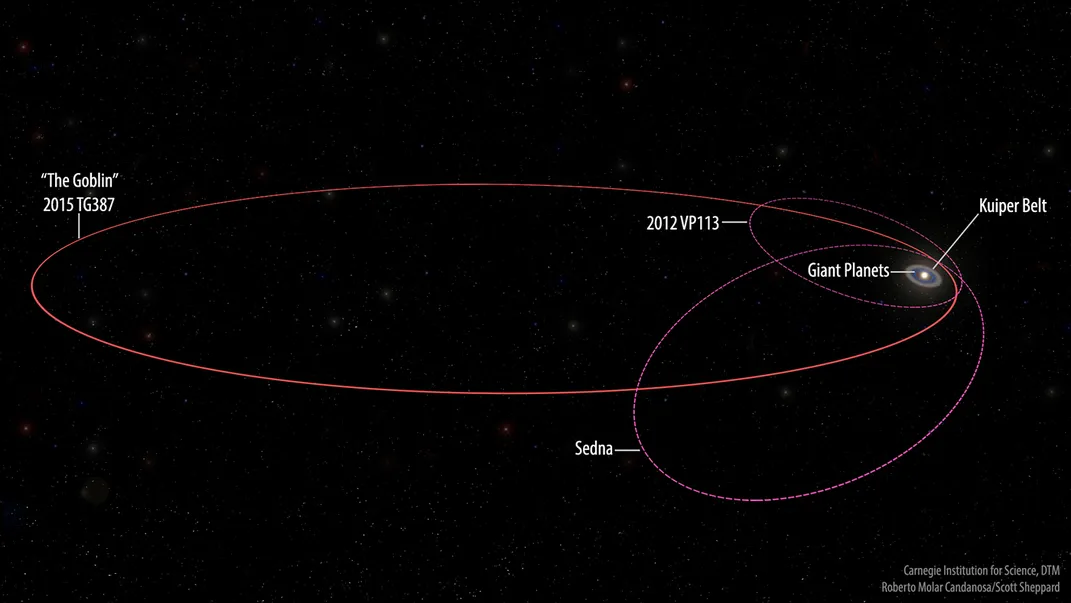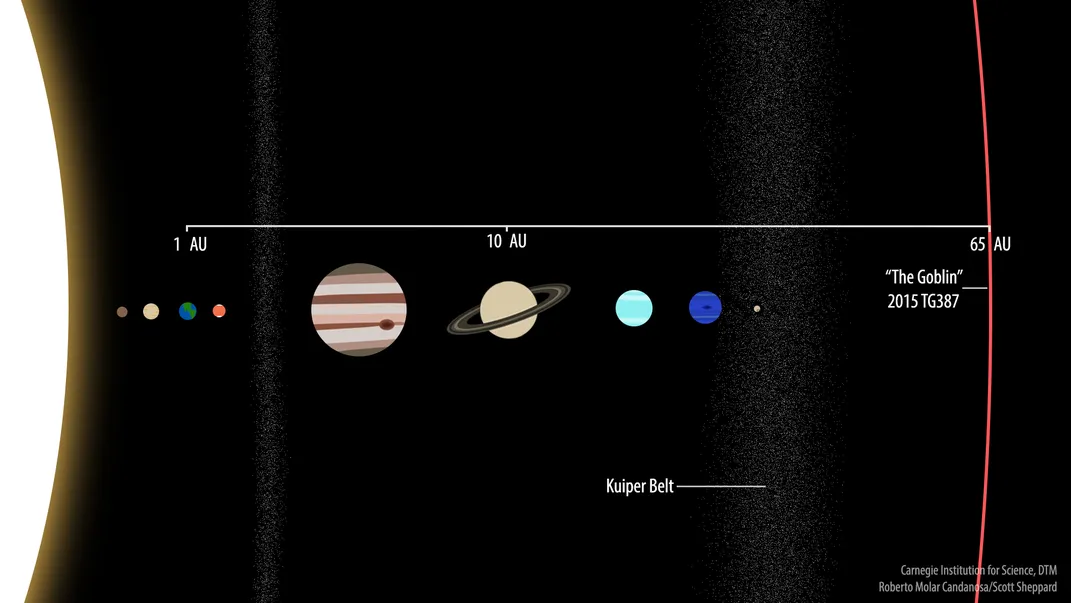New Discovery Stirs Up Signs of the Elusive Planet 9
A new minor planet called “the Goblin” is the second most distant known object in the solar system
/https://tf-cmsv2-smithsonianmag-media.s3.amazonaws.com/filer/20/b5/20b580d6-d0e8-4439-b4b8-a8db74c69080/planet-x-concept-art_carnegiedtm-2.jpg)
It takes Scott Sheppard about 15 minutes to walk to work at the Carnegie Institution’s Department of Terrestrial Magnetism, a research facility in Washington, D.C., that was originally founded in 1904 to support expeditions to map Earth’s magnetic field. Today, the campus hosts planetary scientists of all disciplines, including Sheppard, who studies the celestial bodies of the extreme outer solar system. He says he gets his best ideas while walking and that he is commonly annoyed by intersections, which require just enough attention to prevent the mind from wandering in that inexplicably constructive way. Considering Sheppard is convinced that a large, undiscovered planet orbits the sun well beyond Pluto, one can only imagine where his mind wanders during his morning walks.
The idea that a massive planet, called Planet 9 or Planet X, exists at such a great distance that we have not been able to find it has astronomers around the world scanning the skies for clues. Sheppard, who has discovered some of the most distant objects in the solar system, believes that the orbital paths of these minor planets are most likely shaped by the gravitational influence of a hypothetical Planet 9. And today, his team announced the discovery of yet another extremely distant minor planet—the second farthest known object in the solar system by average distance—that again carries the distinctive mark of a space rock in the grips of an undiscovered giant planet.
“Once a century we find a planet, right? So, it’s time to find one again,” Sheppard says.
The Goblin
The new object, officially called 2015 TG387, orbits with a special class of celestial bodies known as Inner Oort Cloud objects, or extreme trans-Neptunian objects (ETNOs). The body of rock and ice, nicknamed "the Goblin" by the discovery team, is currently about 80 astronomical units (AU) from the sun, or about twice as far as Pluto’s average distance. However, the Goblin travels on a highly elongated orbit that takes it to the extreme outermost reaches of our solar system, looping out as far as 2,300 AU during its 40,000-year journey around the sun.
But as intriguing as the object’s aphelion is, or its most distant point from the sun, the Goblin is perhaps even more interesting for its perihelion, or its closest point. The minor planet, which is estimated at roughly 300 kilometers in diameter (about one-seventh the size of Pluto), only gets as close as 65 AU (six billion miles). Because its closest approach is really not close at all, Sheppard says the Goblin is hardly affected by the gravity of the massive planets such as Jupiter and Neptune.
“It never comes in anywhere near where the giant planets are,” he says. “There’s only three of these objects that stay way out there.”

The other two are Sedna and 2012 VP113, which have perihelia of 76 and 80 AU respectively, though they never travel as far out as the Goblin. When considered together, these three objects start to produce a tantalizing picture of their distant realm. They are decoupled from the rest of the solar system, immune to its influence, and yet they all appear in the same part of the sky.
“If you look at Sedna, and you look at VP113, and you look at a few of the other extreme objects with these very distant orbits, they all are very similar,” Sheppard says. “They all are clustered on the same part of the sky, they all come to perihelion—their closest approach to the sun—at the same place, and you would expect that to be random across the sky. … That’s why we think there’s a bigger planet out there, because it’s shepherding these objects into these types of orbits.”
Other minor planets orbit at extreme distances, such as 2014 FE72, which is the farthest known object by average distance, but they tend to swing in closer to the giant planets. 2014 FE72 can get closer to the sun than Pluto at its closest approach, for example. A convincing explanation for these objects is that they wandered too close to one of the gas giants at some point and were flung out to extreme distances, almost ejected entirely—but when this happens, the rocky objects tend to circle back to near the point from whence they were flung.
When it comes to the Goblin, Sedna and 2012 VP113, something else has trapped them in a lonely orbit, aligned but apart from our little neighborhood of planets.
The Shadow of an Undiscovered Planet
How likely the existence of an undiscovered massive planet is, slowly circling the sun every tens of thousands of years at extreme distances, depends on who you ask. For his part, Sheppard, who has discovered dozens of minor planets, comets and moons, would place the odds of Planet 9 existing at about 80 or 85 percent—and he’s not even the most optimistic.
“My confidence is about 99.84 percent,” says Konstantin Batygin, a planetary astrophysicist and assistant professor at the California Institute of Technology. Batygin creates theoretical models of the outer solar system to search for hints of Planet 9, crunching the numbers on numerous minor planets that cluster into various groups and the influences of dozens of orbital factors. His 2016 paper with Caltech colleague Michael Brown laid out perhaps the strongest case for Planet 9 yet, concluding that there was only a fraction of one percent probability that the groupings of these objects occurred randomly.
“This body is a huge new addition,” Batygin says of the Goblin. “It very much strengthens the case for Planet 9.”

Others aren’t so confident. “I wouldn’t go to the 85 percent level. There are conflicting lines of evidence,” says David Tholen, an astronomer at the University of Hawaii who was part of the team that discovered the Goblin. He points to the Cassini spacecraft, which orbited Saturn for more than 13 years, measuring the dynamics and forces of the outer solar system. “That serves as a very sensitive detector of other things out there, and the analysis of that data suggests that we don’t see any evidence for [Planet 9].”
But even if they don’t buy the Planet 9 hypothesis, most astronomers agree that something unexplained is ripping objects like the Goblin away from the solar system. Some theories suggest that during the early formation of the sun, more than 4.5 billion years ago when other stars were forming nearby, the extreme gravity of a close stellar encounter could have pulled these objects away and left them in a “fossilized” orbit, Sheppard says. Alternatively, perhaps enough of these minor planets exist that they can influence each other’s orbits over many millions of years through a process called self-gravitation, gradually nudging each other farther and farther.
“[If there are] a lot of these minor planets like Sedna and this new object, of course they exert gravitational forces on each other,” says Ann-Marie Madigan, an assistant professor of astrophysics at the University of Colorado, Boulder, who studies models of self-gravitation on distant solar system objects. She says that these minor planets are “so far away from the inner solar system, with the giant planets and things like that, these [self-gravity] forces can actually be extremely powerful. … You don’t need an extra planet out there.”
Madigan admits that self-gravity can’t explain everything about the orbits of the distant minor planets, such as alignment along their “longitude of perihelia,” similar to the major axes of the elliptical orbits. And there are other “outside forces” to consider as well, Sheppard says, such as the galactic tide—the collective gravitational force of everything in the Milky Way including the supermassive black hole at its center. Theories that predict the existence of Planet 9 take all of these influences into account, but an unknown process could be at play as well.
“This is great,” says Michele Bannister, a planetary astronomer at Queen’s University Belfast in the U.K. who co-led the Outer Solar System Origins Survey (OSSOS) from 2013 to 2017, which detected 840 distant minor planets. “We have this whole variety of theories that are trying to explain this population. This is the sign of a good healthy active field.”
Narrowing the Search
Sheppard compares the clustering of the Goblin, Sedna and 2012 VP113 to a relationship between Neptune and Pluto. Though Neptune crosses the orbital path of Pluto, the two planetary bodies never get close to each other because they are locked into a gravitational relationship—known as resonance—that causes Pluto to orbit twice for every three orbits of Neptune. If you didn’t know where Neptune was, you could pinpoint the giant planet by closely observing Pluto. Although the three extremely distant minor planets would not be locked into such a stable relationship with Planet 9, a similar gravitational relationship could be occurring.
If the minor planets are in a gravitational dance with Planet 9, however, it could mean that the big planet is far, far away—near the aphelion of its orbit roughly 1,000 AU from the sun. We have only a rough idea of Planet 9’s size—between two and four times that of Earth, if it exists—and no way to determine its how much light it reflects, which makes it incredibly difficult to search for. The only reason we have been able to find smaller distant objects like the Goblin is because they are near their closest approach, visible for just an instant of stellar time before they sling back out into the shadows.
/https://tf-cmsv2-smithsonianmag-media.s3.amazonaws.com/filer/1a/11/1a11368f-4cc7-4a61-918e-1150b93376e0/2015_tg387_movie.gif)
“Ninety-nine percent of their orbit, we would not find them,” Sheppard says. “So, we just find the tip of the iceberg.”
The hunt for Planet 9 suffers from a serious lack of data—for now. It’s difficult to draw statistical conclusions with such a small sample size of minor planets, especially when thousands likely exist. “Every one of these detections implies a vast, unseen population,” Bannister says. “And so observational biases can really affect the conclusions you draw about the existence of that vast unseen population, and what shapes its orbits take in space, and what potentially they are being shaped by or could have been shaped by.”
The Goblin was first spotted in 2015 by the Japanese 8-meter Subaru telescope on Mauna Kea in Hawaii, but the minor planet is so far away that three years of follow-up observations were required with telescopes in Chile and Arizona before its orbit could be calculated, revealing its true path and distance. Several additional minor planets have been discovered, and when astronomers refine their orbital parameters, they will have a better idea of where the massive planet is hidden—if anywhere at all.
/https://tf-cmsv2-smithsonianmag-media.s3.amazonaws.com/filer/b4/c1/b4c1558a-0a11-4ea0-a163-cdfabd28c473/maunakea_subaru.jpg)
“The fact that Planet 9 is, at the end of the day, either there or not there, and the math that I’ve done is either right or wrong, is actually a beautifully attractive aspect of this whole problem,” Batygin says. “This isn’t one of these problems where you can speculate about it until you die. … I think the next 10 years is plenty of time.”
Continued surveys of the sky with telescopes like Subaru and new observatories such as the Large Synoptic Survey Telescope (LSST)—which will have the largest digital camera in the world at 3.2 gigapixels, about the size of a small car—will discover even more objects as our understanding of the solar system grows. Additional astronomy work, such as the second data release from the Gaia space telescope, help refine our models of the movements of the stars throughout the history of the galaxy, further tightening the constraints on the extremely distant minor planets.
If and when all this work leads to the discovery of Planet 9, Sheppard says, “it will be a triumph of science."
/https://tf-cmsv2-smithsonianmag-media.s3.amazonaws.com/accounts/headshot/bennett.jpg)
/https://tf-cmsv2-smithsonianmag-media.s3.amazonaws.com/accounts/headshot/bennett.jpg)